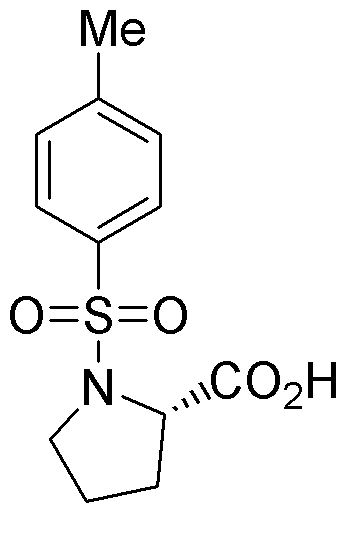Tosyl-L-proline is widely utilized in research focused on:
- Peptide Synthesis: It serves as a valuable building block in the synthesis of peptides, enhancing the efficiency and selectivity of reactions.
- Drug Development: This compound is used in medicinal chemistry to develop new pharmaceuticals, particularly in creating compounds with improved bioactivity.
- Asymmetric Synthesis: Tosyl-L-proline is instrumental in asymmetric synthesis, allowing researchers to produce chiral molecules with high enantioselectivity.
- Catalysis: It acts as a catalyst in various organic reactions, providing advantages in reaction rates and yields compared to traditional catalysts.
- Biochemical Research: This compound is employed in biochemical studies to investigate enzyme mechanisms and protein interactions, offering insights into biological processes.
General Information
Properties
Safety and Regulations
Applications
Tosyl-L-proline is widely utilized in research focused on:
- Peptide Synthesis: It serves as a valuable building block in the synthesis of peptides, enhancing the efficiency and selectivity of reactions.
- Drug Development: This compound is used in medicinal chemistry to develop new pharmaceuticals, particularly in creating compounds with improved bioactivity.
- Asymmetric Synthesis: Tosyl-L-proline is instrumental in asymmetric synthesis, allowing researchers to produce chiral molecules with high enantioselectivity.
- Catalysis: It acts as a catalyst in various organic reactions, providing advantages in reaction rates and yields compared to traditional catalysts.
- Biochemical Research: This compound is employed in biochemical studies to investigate enzyme mechanisms and protein interactions, offering insights into biological processes.
Documents
Safety Data Sheets (SDS)
The SDS provides comprehensive safety information on handling, storage, and disposal of the product.
Product Specification (PS)
The PS provides a comprehensive breakdown of the product’s properties, including chemical composition, physical state, purity, and storage requirements. It also details acceptable quality ranges and the product's intended applications.
Certificates of Analysis (COA)
Search for Certificates of Analysis (COA) by entering the products Lot Number. Lot and Batch Numbers can be found on a product’s label following the words ‘Lot’ or ‘Batch’.
*Catalog Number
*Lot Number
Certificates Of Origin (COO)
This COO confirms the country where the product was manufactured, and also details the materials and components used in it and whether it is derived from natural, synthetic, or other specific sources. This certificate may be required for customs, trade, and regulatory compliance.
*Catalog Number
*Lot Number
Safety Data Sheets (SDS)
The SDS provides comprehensive safety information on handling, storage, and disposal of the product.
DownloadProduct Specification (PS)
The PS provides a comprehensive breakdown of the product’s properties, including chemical composition, physical state, purity, and storage requirements. It also details acceptable quality ranges and the product's intended applications.
DownloadCertificates of Analysis (COA)
Search for Certificates of Analysis (COA) by entering the products Lot Number. Lot and Batch Numbers can be found on a product’s label following the words ‘Lot’ or ‘Batch’.
*Catalog Number
*Lot Number
Certificates Of Origin (COO)
This COO confirms the country where the product was manufactured, and also details the materials and components used in it and whether it is derived from natural, synthetic, or other specific sources. This certificate may be required for customs, trade, and regulatory compliance.


